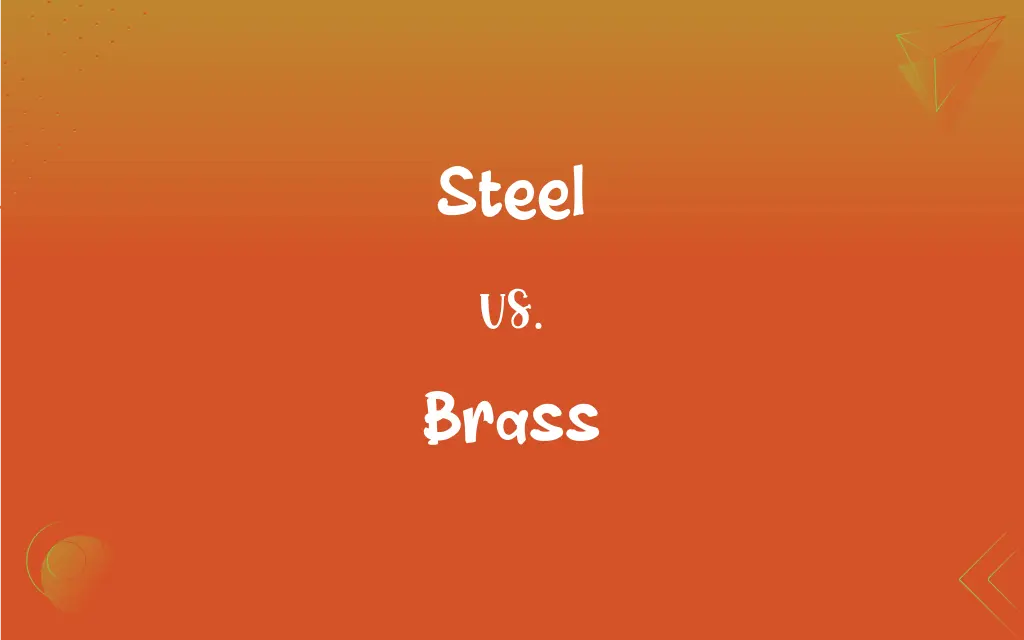Steel vs. Brass: What's the Difference?
Edited by Harlon Moss || By Janet White || Published on January 28, 2024
Steel is an alloy of iron and carbon, known for strength and durability, while brass is an alloy of copper and zinc, noted for corrosion resistance and malleability.

Key Differences
Steel, an alloy primarily made of iron and carbon, is renowned for its strength and durability, making it ideal for construction and manufacturing. On the other hand, brass, composed of copper and zinc, is known for its corrosion resistance and aesthetic appeal, often used in decorative and musical applications.
The production process of steel involves the combination of iron with a small percentage of carbon, which enhances its hardness and tensile strength. In contrast, brass is produced by combining copper with zinc, resulting in an alloy with unique acoustic properties, making it popular in musical instruments.
Steel can be further classified into various types, such as stainless steel, depending on additional elements added, such as chromium, to improve specific properties like rust resistance. Brass, however, varies based on the proportion of copper to zinc, with different ratios yielding varying degrees of ductility and color.
The uses of steel are diverse, ranging from infrastructure, vehicles, to machinery, due to its high strength and versatility. Brass, while also versatile, finds more specialized uses such as in plumbing fixtures, decorative items, and brass instruments due to its malleability and distinctive color.
In terms of cost and environmental impact, steel is generally more cost-effective and has a larger carbon footprint due to the energy-intensive production process. Conversely, brass is often more expensive but can be more sustainable, as both copper and zinc are recyclable materials.
ADVERTISEMENT
Comparison Chart
Composition
Iron and carbon alloy
Copper and zinc alloy
Physical Property
Strong and durable
Malleable and ductile
Color
Silvery-gray to black
Yellow to golden
Corrosion Resistance
Less resistant, varies with type
Naturally corrosion-resistant
Primary Use
Construction, tools, vehicles
Decorative items, instruments
ADVERTISEMENT
Steel and Brass Definitions
Steel
Symbolic of strength and resilience.
Her steel determination was evident in her achievements.
Brass
Boldness or impudence.
He had the brass to challenge the CEO’s decision.
Steel
A bluish-grey color akin to the metal.
The car's steel exterior gleamed in the sunlight.
Brass
Bright yellow-gold color like the alloy.
The artist captured the brass hue of the sunset perfectly.
Steel
To mentally prepare oneself for something difficult.
She steeled herself for the challenging interview.
Brass
A malleable alloy of copper and zinc.
The antique clock was adorned with intricate brass detailing.
Steel
To make an object or structure stronger.
The carpenter steeled the wooden frame for extra support.
Brass
A section of a band or orchestra with brass instruments.
The brass section led the symphony with a triumphant melody.
Steel
A hard, strong alloy of iron and carbon.
The bridge was constructed with high-grade steel.
Brass
High-ranking military officers, often collectively.
The decision was made by the top brass at the headquarters.
Steel
A generally hard, strong, durable, malleable alloy of iron and carbon, usually containing between 0.2 and 1.5 percent carbon, often with other constituents such as manganese, chromium, nickel, molybdenum, copper, tungsten, cobalt, or silicon, depending on the desired alloy properties, and widely used as a structural material.
Brass
A yellowish alloy of copper and zinc, sometimes including small amounts of other metals, but usually 67 percent copper and 33 percent zinc.
Steel
Something, such as a sword, that is made of steel.
Brass
Ornaments, objects, or utensils made of this alloy.
FAQs
What is steel made of?
Steel is an alloy of iron and carbon.
Is brass magnetic?
No, brass is not magnetic.
Which is heavier, steel or brass?
Steel is generally heavier than brass.
What is brass made of?
Brass is an alloy of copper and zinc.
Are brass fittings suitable for plumbing?
Yes, brass is commonly used in plumbing fixtures.
Can steel rust?
Yes, steel can rust without proper treatment.
What is stainless steel?
Stainless steel is a type of steel alloy with chromium to prevent rust.
Is steel magnetic?
Yes, most steel types are magnetic.
Is steel used in buildings?
Yes, steel is widely used in construction.
Is brass used in musical instruments?
Yes, brass is commonly used in musical instruments.
Can steel be recycled?
Yes, steel is highly recyclable.
Can steel withstand high temperatures?
Yes, steel can withstand high temperatures.
Is steel more expensive than brass?
Generally, steel is less expensive than brass.
Can brass be used in outdoor applications?
Yes, brass is suitable for outdoor use due to its corrosion resistance.
Does brass tarnish?
Yes, brass can tarnish but is corrosion-resistant.
Does steel conduct electricity?
Yes, steel conducts electricity.
Is brass recyclable?
Yes, brass is also recyclable.
Is brass a good electrical conductor?
Brass is a moderate conductor of electricity.
Is brass used in coins?
Yes, brass is used in the production of some coins.
Which is more malleable, steel or brass?
Brass is more malleable than steel.
About Author
Written by
Janet WhiteJanet White has been an esteemed writer and blogger for Difference Wiki. Holding a Master's degree in Science and Medical Journalism from the prestigious Boston University, she has consistently demonstrated her expertise and passion for her field. When she's not immersed in her work, Janet relishes her time exercising, delving into a good book, and cherishing moments with friends and family.
Edited by
Harlon MossHarlon is a seasoned quality moderator and accomplished content writer for Difference Wiki. An alumnus of the prestigious University of California, he earned his degree in Computer Science. Leveraging his academic background, Harlon brings a meticulous and informed perspective to his work, ensuring content accuracy and excellence.































































